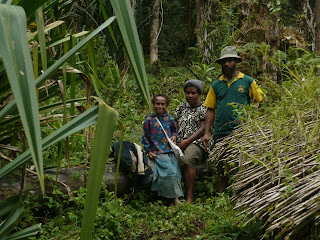This journey commences from Kandep's Kolopa all the way to Last Karinz. Tap road is the only road that passes through the mountain range that separates Kandep and Last Karinz. The author started this journey from Kandep all the way to Last Karinz.
A village boy relaxed for a shot all in smiles at Kap ipa on the Enga side of the border. Note the drainage system and how best the villages have kept this road clear by cutting down the bushes just enough for use by foot.
Long distance walk at Kap ipa - on the Kandep side of the border. Long distance walk is a routine job for the people there as part of their daily struggle.
This is right at the top of Tap mountain where looking towards your right is Enga's Kandep and on the left is last Karinz and SHP. The road condition here has deteriorated and is impassable by vehicle.
As part of the normal daily struggle, the people have to walk long distances from Kandep's Kambiya to Last Karinz. Photo taken at Tap mountain, the border of Kandep in Enga and Last Karinz in SHP. These people really need at least a feeder road network to make their daily travel easier. They have hardly seen any sign of government service delivery for all their life for generations. Photo showing author walking together with clansman.
This is on the Last Karinz side of the mountain at a typical location called Kipyal. Better road network is one tangible change that the people are yet to see in the decades to come. An appeal for a better road by way of casting their votes during national elections have fallen on deaf ears, political leaders have come and gone but changes to their only road has never eventuated.
This is at Tap mountain again. At the back ground is peya mountain, one of the many mountain peaks towards the eastern side of last Karinz.
A young man who travelled together with the author posing for a shot after having a much needed drink from one of the icy water stream, wara magani (not magani at mendi town) at Tap mountain.
This is the same Mountain that ranges all the way from to Momde and Pura in Kandep, Enga Province. This is a typical normal day, at most times rainy and gloomy. You would always expect rain while visiting this place.
Two village boys posing for a shot at Kipyal with bows and arrow in hand. This is the location where people rest for a while and take a much needed breath before walking the next kilometres of their route.
Like any other family unit, this small boy was seen carrying a pandanas nut from Last Karints to Kandep as part of his daily contribution for the for food.
Posing for a much needed rest at Kipyal. This is also the only location where Digicel network reception is received. It takes a day to come to this area to make a call and then back home.
All smiles for a typical village boy for a shot. This particular location has a history where this road was first built by hand tools during the colonial era, that is, the two separate teams building the road from Kandep and Mendi meet at this location.
The same mountain range, this time on the Mendi side while travelling down from Kandep side.
This is on the SHP side of the border. On the background is the mountain ranges that extends from peya mountain all the way to Kandep's Pako, Kambiya and Momode in Enga Province.
This was once a road that has been used by vehicle the one last seen was way back in 2006. Road block due to land slide like this is common and people only have to clear way for walking by foot.
This location is where the home to the author is located. This location is also a great look out has the only location where Digicel network reception is at its peak.
This is now a typical village setting with fence. This the other mountain range that extends all the way to Murimb and Kolopa. Beyond this mountain are many fresh water streams with abundance of rainbow trouts. a local nut also from the well known betel nut family is found on this side of the mountain.










































